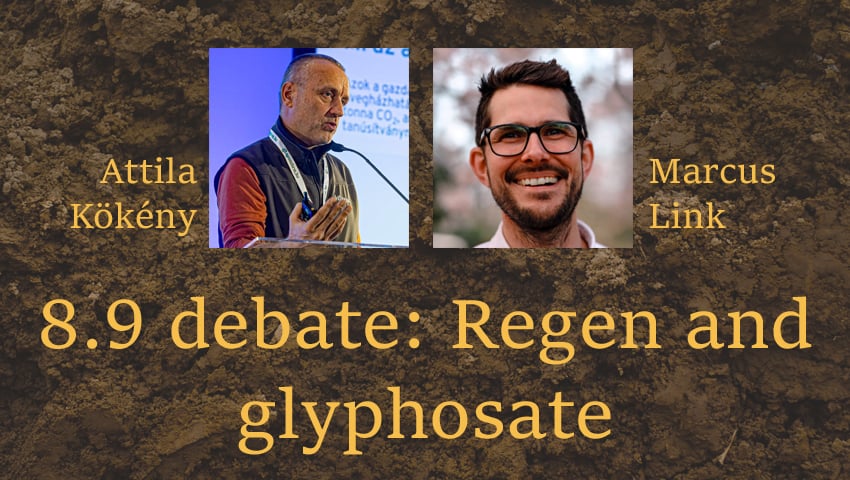Throughout this week, two reg ag practitioner-experts will debate the contentious issue of glyphosate in a series of articles.
Is glyphosate critical to regenerative agriculture?
- Today Marcus Link, from New Foundation Farms, responds to Attila Kökény, a regenerative agriculture consultant from Hungary
- Read Attila’s opening statement below
- Attila will respond to Marcus tomorrow
- The views of the correspondents do not necessarily reflect the views of the 8point9.com team.
MARCUS LINK RESPONDS TO ATTILA:
There is the myth that the agricultural revolution was a uniform thing that happened to all humans everywhere about 12,000 years ago. It persists in spite of the evidence in favour of a plurality of humankinds which did different things in different places and by and large produced two kinds of design approaches: the imperial and the custodial.
The imperial approach separates humankind from nature, divides the world into resources, and views these and the land as commodities. It tends to regard evolution as a matter of competition in the face of adversity. Its economics borrow the term supply chain from the slave trade to organise extractive activity on the assumption that such chains mean greater economic benefit which can then be geared towards greater efficiency and competitive advantage.
This shows in its approach to agriculture in the simplification of formerly complex landscapes in favour of monocultures at enormous scale, which are, of course, the opposite of ecosystems.
It is possible to farm in ways that builds ecosystems. This is sometimes referred to as regenerative agriculture. Whilst regeneration is an outcome, the term is often misused to label practices. Given the low baseline of soils degenerated by decades of mechanical and chemical abuse, such practices are likely to show signs of improvement when the regime is even only slightly altered.
No-till reduces the impact on the soil and allows it to rest, and because of the rest, life returns if there is enough water for the latent biology. This is when we find ourselves faced with an abundance of ‘weeds’. Enter the weedkiller glyphosate, an apparently simple solution which promises to deliver croppable monocultures for humans and regeneration for soils.
This is, however, a flawed systems design approach. There are no weeds. There are only ecosystem health indicators that act like a mirror to our worldview and its practices. No-till may be a good if misguided start, but glyphosate is where it then already ends. We need to collaborate with biodiversity above and below ground. The enemy is not the weed but our design approach.
The custodial design approach understands humankind as of nature, as one species in the interdependent larger-than-human community. It understands land and ecosystem processes as part of this community. In this view, evolution is an outcome of collaboration and yields improve when reciprocity is greater.
The job here is to steward non-linear, complex, anti-fragile ecosystems in which food grows, abundantly. To differentiate this from the glyphosated version, I call this deep regeneration. Some say that we cannot operate agriculture at scale to feed the world with deep regeneration.
I am reassured not just by many examples from the history of humankind but also from current practitioners such as Leontino Balbo Jr. who has shown that we can produce organically with yields 25% higher than conventional practice at 30,000+ hectare scale when we understand our crop as part of a complex ecosystem with biodiversity levels which rival nearby national parks.
Read more about New Foundation Farms
OPENING STATEMENT BY ATTILA KÖKÉNY:
This is a good proposition, because food production that is based on principles of regenerative agriculture can only be truly sustainable without external inputs.
In the current supply and trade structure of Western civilisation, commodities are produced on the largest land. An important activity in arable cropping is weed control, which farmers have practised for more than 12,000 years by tilling the soil.
This is about the same time as the first man-made erosion sediments appeared in lakes. Dust Bowl events were already blowing and mudflows were washing away ploughed topsoil at the beginning of Holocene, even though the ox-drawn ards tilled the soil only to the depth of current minimum tillage technology.
Think of the Greek and Spanish deserts, where rocky, barren land was once sea to sea forests and grasslands. These fertile soils have all been eroded by agriculture, which has also disrupted small water cycles, terminated local rainfalls, and turned once rich lands into man-made deserts.
Agriculture has eroded several metres of fertile topsoil all over the world and the intensification of this activity continues to cause incalculable economic, environmental and health damage.
The eradication of this Stone Age technology only began in the 1960s with the introduction of no-till farming, after the first herbicides such as 2,4D, Atrazine and Paraquat appeared. These highly toxic herbicides are dangerous to use (although, interestingly, no one is campaigning against them worldwide), so no-tillers were relieved when glyphosate entered into market. However, farming is still dominated by tillage, which is responsible for the 60-70% humus loss of our soils.
This degenerative technology can only be reversed by regenerative agriculture based on no-till. The simplest regenag is holistic grazing, as there are no more weed problems that require tilling or herbicides.
In arable farming, cover crops, crop rotation, mulching and grazing all help to reduce weed pressure, but there are no miracles.
Weeds don’t just go away, they reduce yields significantly and put our health at risk with toxic chemicals, like tropans.
Besides annual weeds, it’s the ever-growing number of perennial weeds that cause the biggest headaches.
So the farmer can choose to till the soil 5 or 6 times a year when, for example, Canada thistle appear on the fields, exhausting the plant and causing staggering structural damage, moisture loss and erosion to soil, or successfully control them with 2 to 3 drops of glyphosate per square metre in a no-till system.
